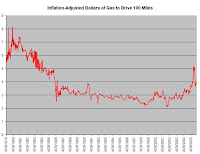
One of my regular readers emailed me with link to this ABC news article. He dismissed the price comparisons with other products on the basis that gasoline is a neccesity, while the other products were luxury items. But he found the inflation-adjusted gasoline price “interesting", by which I assume he means “surprising”.
I’ve been talking with friends and relatives about this “interesting” fact for months (and even mentioned it in a previous blog post). The surprising part for me is how much trouble people seem to have accepting that this is so — it appears to me that something in the human mind is “stuck” on absolute price comparisons. The inflation analysis is one of the few things about the gasoline price controversy that’s subject to unambiguous (and uncontroversial!) analysis, and many people have done exactly that. The result is uniform across all sources that I’ve found: in inflation-adjusted dollars, gasoline has not yet reached new all-time highs. It’s getting close, mind you — but it’s not there.
But I will share something else with you that I find very interesting, and its encapsulated in the graph above right that I stole shamelessly from this excellent post on the equally excellent libertarian Coyote Blog.
This graph shows what it has cost us (in inflation-adjusted dollars) over the years to drive 100 miles. This is an even better reflection of how gasoline prices actually affect us. This graph looks very different than the simply inflation adjusted graph (which is also in that post at Coyote Blog) because, on average, our cars today get much better gas mileage than they did in 1980.
All of the above facts appear to me to be undeniable. One can quibble about precisely how inflation is measured, but surely the fact of inflation is accepted by everyone. Ditto gasoline mileage. So one might see minor variations in these charts, but the gist will be the same: in real terms, gasoline is not near it’s all-time 1980 highs yet. If I do the math, today’s $3.50/gallon gas would have to be $5.60/gallon to match those 1980 highs — taking into account both inflation and the better mileage.
So why do people seem to have so much trouble accepting this? Any theories out there?

No comments:
Post a Comment